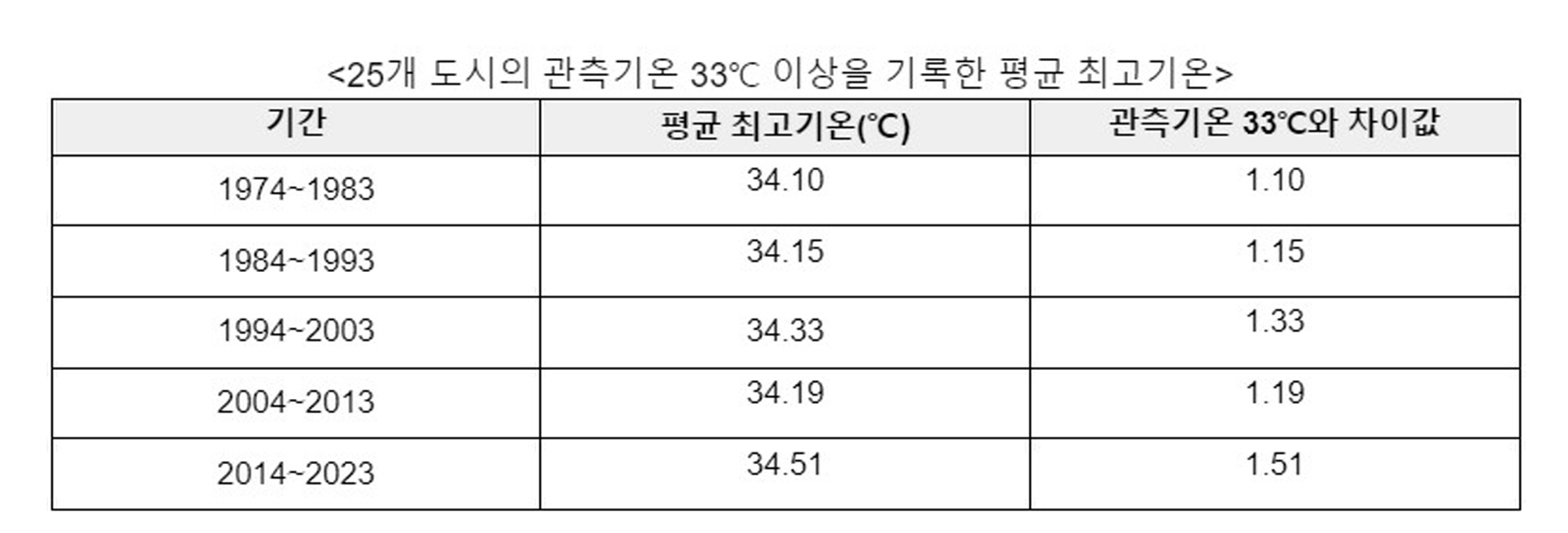
In the last decade, the number of days experiencing a perceived temperature of over 35°C has more than doubled compared to 20 years ago. It has also been found that the duration of heat waves has increased.
On the 13th, Greenpeace released a report based on meteorological data, investigating the number of heat wave days in major cities over the last 50 years (1974-2023) during the summer months (May to September). The study revealed that the average number of days with a perceived temperature above 35°C in recent years (2014-2023) across 25 cities (including Gangneung, Wonju, Suwon, Icheon, Geoje, Jinju, Gumi, Pohang, Mokpo, Yeosu, Gunsan, Jeonju, Seogwipo, Jeju, Seosan, Cheonan, Jecheon, Cheongju, Gwangju, Daegu, Daejeon, Busan, Seoul, Ulsan, and Incheon) was 51.08 days—more than double the 20.96 days recorded 20 years ago (2004-2013).
Furthermore, the duration of heat waves has also lengthened. An analysis of how many days temperatures remained above 35°C revealed that the average duration of heat waves in the last decade was 2.4 days, an increase of more than 0.5 days compared to 1.9 days from 20 years ago.
Cases where heat waves lasted more than two days have also significantly increased. In the past decade, instances of weather exceeding 35°C for more than two consecutive days totaled 40.56 occasions, significantly higher than the 14.68 instances recorded 20 years ago. When comparing this to 30 years ago (1994-2003), where there were only 10.4 occurrences, it reflects a threefold increase.
Additionally, to measure the intensity of heat waves, the number of days where recorded temperatures exceeded 33°C was separately aggregated. The average maximum temperature recorded over the past decade was 34.51°C, which is 0.3 degrees higher than the 20 years prior (2004-2013). This indicates that the average temperature on heat wave days is rising, and the intensity is consistently increasing as well.
When looking at individual cities, it was noted that the number of days exceeding a perceived temperature of 35°C has increased across all locations. Gumi, Gwangju, Daejeon, and Daegu were the cities with the highest number of heat wave days over the past decade, with Gumi leading at 106 days, followed closely by Gwangju at 105 days, Daejeon at 96 days, and Daegu at 83 days. The most significant increases were seen in Gumi and Gwangju, where Gumi rose from 23 days 20 years ago to 106 days, while Gwangju increased from 35 days to 105 days.
Last year marked the hottest year on record for the planet. According to the World Meteorological Organization (WMO), this year is projected to break temperature records again. Notably, the warming rate in Asian regions, including South Korea, is faster than the global average. The ‘Climate Change Adaptation Report (2023)’ from South Korea indicates a rise in temperatures of approximately 1.6°C from 1912 to 2020, surpassing the global average increase of 1.09°C.
Lee Sun-joo, a climate and energy campaigner at Greenpeace, stated, “The results of this study starkly show that the Earth’s temperature continues to rise. As the climate crisis deepens, extreme weather events, including heat waves and heavy rains, are becoming larger and more frequent, leading to increased uncertainty and greater damages.” He further emphasized the necessity for swift greenhouse gas reduction efforts and the development of long-term measures at the government level to respond to these climate disasters.
Lee Sang-jin daedusj@autodiary.kr
